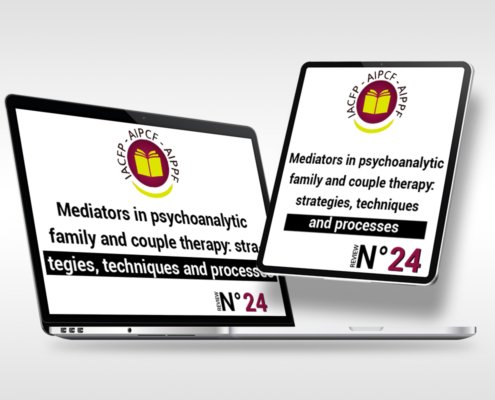REVIEW N° 24 | YEAR 2021 / 1
Introduction to the issue “Mediators in psychoanalytic family and couple therapy: strategies, techniques and processes”
Christiane Joubert [*], Christophe Bittolo[**]
The use of mediators, which is nowadays quite common in individual and group therapy, seems to be less known and less debated in couple and family psychoanalysis.
In the field of group clinical practices, numerous publications about the psychic processes activated by therapeutic mediations (Lecourt, 1988; Chouvier et al., 2002; Vacheret et al., 2002) highlight the importance of the medium in articulating the affects and sensations mobilised and actualised in sessions. Supporting this articulation in the therapeutic process allows the unspeakable character of an experience to enter the realm of imagination and thought. The transition it mobilises, and the intermediate psychic space it opens up, counteract the impasses blocking psychic transformation through symbolisation as well as interphantasizing.
Within the framework of PFT (Psychoanalytic Family Therapy), the psychodrama experimented by Decherf and then Wainrib (2005) and taken up by Marine Ruffiot (2014), was undertaken using different techniques already present in child psychotherapy: drawings, finger paintings, imaginative games, characters, puppets (Jaitin, 2002), masks, animals, collages, toys (elastic ball, animals), etc. These mediators represent and support the expression of emotions such as anger, care and anxiety.
Other more specific techniques have emerged in the context of psychoanalytical family and couple therapy: Photolangage©, group mediation (Vacheret, 2002; Durastante, Joubert, 2013; Joubert 2016; 2017; Drieu, 2016); writing; music; talking stick; paintings belonging to the therapist (Darchis, 2016); the house plan; free drawings of the dream house; the family tree (Cuynet, 2005; 2015; 2016; Sommantico, 2007); the spatiogram (Benghozi, 2006; 2014) and the possible recovery of the family body in a shared transitional space (Morosini, 2014). These media mobilise representations of the unconscious image of the individual and family. We are obviously only quoting a few authors. The techniques are numerous and mobilize the process. Mediators raises questions about the functions it performs for the therapist(s) at different levels. Its choice and use cannot be considered apart from the conception that the clinician has of his device. Firstly, an anticipated counter-transference forms the therapeutic space in which the therapist anticipates the difficulties to be overcome and what might open or close the expression of what he/she expects before being surprised by the unexpected – something inherent in clinical work. Secondly, mediation is a component of the therapeutic alliance and involves the subjective investment of the therapist(s). It then becomes a mode of expression of his or her involvement, chosen according to the blockages or impasses felt during the therapy. But it can also constitute a defensive recourse against what the family or the couple mobilise in the transferential field. Finally, in a co-therapy situation, mediation questions the link formed between clinicians and their intertransferential analysis. Mediation also encourages a creative availability through listening, favouring empathy and the involvement of the therapists. The transferential field is then at work. It is in connection with questions such as these that we present various contemporary articles addressing the processes of mediation in psychoanalytical family and couple therapy. Here is the summary.
[*] Clinical psychologist, Psychotherapist. Psychoanalyst-Family, Group, Couple Trainer in Psychoanalytical Family Therapy and Photolanguage. Member: French Society of Psychoanalytical Family Therapy, International Association for Couple and Family Psychoanalysis, French Society of Group Psychoanalytic Psychotherapy. Professor Emeritus of the Universities – in Clinical Psychopathology – University of Toulouse 2, Jean Jaurès, member of the LCPI laboratory. christianejoubert@netcourrier.com
[**] Clinical psychologist, psychoanalyst, group and institutional analyst. Assistant professor in clinical psychology and psychopathology. Member: PCPP Laboratory, EA 4056, University of Paris, Transition Association, Paris Institute of Psychoanalysis, International Association of Couple and Family Psychoanalysis, French Society of Group Psychoanalytic Psychotherapy. christophe.bittolo@neuf.fr

